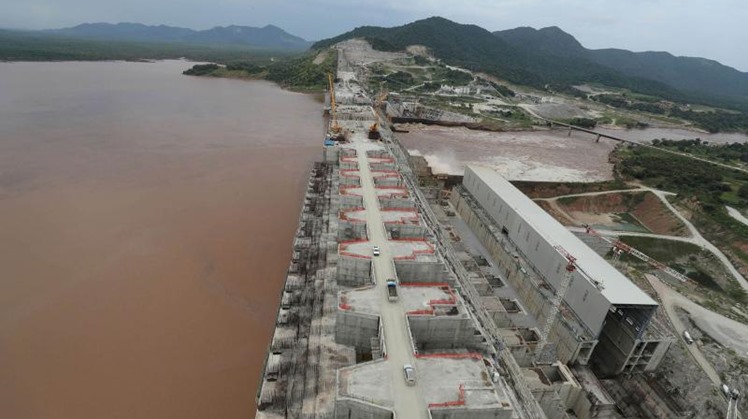CAIRO – 4 October 2025: Egypt claimed that Ethiopia’s “reckless” management of the Grand Ethiopian Renaissance Dam (GERD) triggered an unusually severe and delayed flood on the Nile beyond the normal seasonal peak.
In a statement issued on Friday, the Egyptian Ministry of Water Resources and Irrigation denounced Ethiopia’s "unilateral" management of its "illegal dam that violates the international law." The $5 billion mega dam is capable of holding back up to 74 billion cubic meters of water.
The ministry stressed that sudden, uncoordinated water releases last month created a “man-made flood” that inundated farmland and villages in Sudan and “placed the lives and resources of the populations of the two downstream countries (Egypt and Sudan) at risk.”
Egypt emphasized that such unilateral practices by Ethiopia “lack the most basic standards of responsibility and transparency, and pose a direct threat to the lives and security of the peoples of the downstream countries.”
Moreover, the “unregulated and chaotic” dam management, Egypt stressed, “exposes as false Ethiopia’s repeated claims that its actions cause no harm to others.”
Cairo accused Addis Ababa of “political exploitation of water at the expense of human lives and regional security.”
The Egyptian ministry detailed the scientific reasons behind the “man-made flood,” blaming it on “Ethiopian rush to complete the filling in an unregulated manner … in pursuit of a mere media snapshot” during the dam’s inauguration on 9 September.
Egypt accused Ethiopian dam operators of “flouting accepted technical and scientific practices” by stockpiling far more water than expected at the end of August while sharply reducing releases from about 280 million cubic meters a day to just 110 million cubic meters on 8 September.
The ministry affirmed that Ethiopia, instead, should have followed a gradual and scientifically regulated process of storing water in GERD between July and October, before releasing it steadily throughout the year to generate electricity.
The Blue Nile’s flood season runs from July to October and typically peaks in August, the statement noted.
The ministry stated that the recent unilateral filling of the dam by Ethiopian operators was designed to quickly raise water levels to 640 meters above sea level.
Ethiopia then opened the dam’s middle and emergency spillways for only a few hours, solely for a “media snapshot and political show” during the inauguration “without any regard for water safety or the interests of downstream states.”
The ministry said Ethiopia abruptly and ‘without justification’ released massive volumes of stored water, estimated at about 2 billion cubic meters, during September.
On 10 September, after the dam inauguration, operators discharged an estimated 485 million cubic meters of water in a single day, followed by “sudden and unexplained” surges that peaked at 780 million cubic meters on 27 September, before dropping to 380 million on 30 September.
Estimates showed a drop of nearly one meter, equivalent to the release of about 2 billion cubic meters of stored water, besides the normal flood-related discharges.
This, Egypt said, increased the volume of water released downstream and underscored “the unregulated and chaotic nature of the dam’s management.”
Egypt emphasized that the delayed and more acute flood has inflicted severe losses on Sudan, citing reports from the United Nations Office for the Coordination of Humanitarian Affairs (OCHA).
Sudanese authorities reported this week that floodwaters from the swollen Nile River have encircled at least seven districts in Sudan’s capital, Khartoum, Sudan Tribune reported.
The ministry underscored that the convergence of the unusually large volumes of water from the dam at this time of year, combined with delayed and irregular rainfall in Sudan and higher-than-normal flows from the White Nile, led to a sudden surge in water levels, flooding large areas of farmland and inundating numerous Sudanese villages.
Faced with these emergency conditions, operators of Sudan’s Roseires Dam had no option but to store only a small portion of this water and pass the majority through its gates to protect the safety of the dam, given its limited storage capacity, the ministry explained.
This year’s flood levels at the Nile’s main three tributes – the White Nile, the Blue Nile, and the Atbara River – were about 25% above average, though still lower than last year’s unusually high flood, the ministry noted.
Egypt refuted Ethiopia’s repeated claims that the dam would regulate floods and protect Sudan from inundation, while providing power for the Ethiopian people.
Egypt and Sudan have long condemned Addis Ababa’s filling and operation of the mega dam without a legally-binding agreement that ensures the water rights of both downstream nations and protect their populations during the periods of extended drought.
“Egypt has repeatedly warned that the existence of a dam storing 74 billion cubic meters in violation of international law and without a binding legal agreement, combined with such chaotic and reckless management, represents a constant and ongoing threat to the downstream countries during both droughts and floods,” the ministry underscored.
 Sat, Oct. 4, 2025
Sat, Oct. 4, 2025